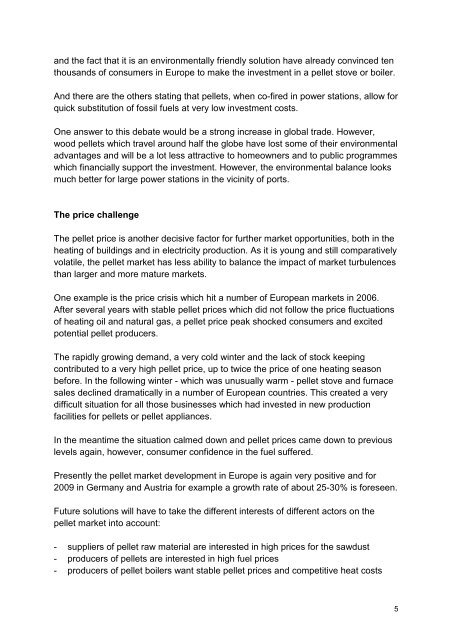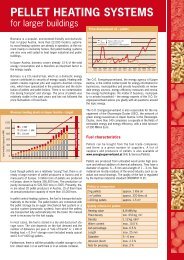Key Issues for Wood Pellet Market Development
Key Issues for Wood Pellet Market Development
Key Issues for Wood Pellet Market Development
You also want an ePaper? Increase the reach of your titles
YUMPU automatically turns print PDFs into web optimized ePapers that Google loves.
and the fact that it is an environmentally friendly solution have already convinced ten<br />
thousands of consumers in Europe to make the investment in a pellet stove or boiler.<br />
And there are the others stating that pellets, when co-fired in power stations, allow <strong>for</strong><br />
quick substitution of fossil fuels at very low investment costs.<br />
One answer to this debate would be a strong increase in global trade. However,<br />
wood pellets which travel around half the globe have lost some of their environmental<br />
advantages and will be a lot less attractive to homeowners and to public programmes<br />
which financially support the investment. However, the environmental balance looks<br />
much better <strong>for</strong> large power stations in the vicinity of ports.<br />
The price challenge<br />
The pellet price is another decisive factor <strong>for</strong> further market opportunities, both in the<br />
heating of buildings and in electricity production. As it is young and still comparatively<br />
volatile, the pellet market has less ability to balance the impact of market turbulences<br />
than larger and more mature markets.<br />
One example is the price crisis which hit a number of European markets in 2006.<br />
After several years with stable pellet prices which did not follow the price fluctuations<br />
of heating oil and natural gas, a pellet price peak shocked consumers and excited<br />
potential pellet producers.<br />
The rapidly growing demand, a very cold winter and the lack of stock keeping<br />
contributed to a very high pellet price, up to twice the price of one heating season<br />
be<strong>for</strong>e. In the following winter - which was unusually warm - pellet stove and furnace<br />
sales declined dramatically in a number of European countries. This created a very<br />
difficult situation <strong>for</strong> all those businesses which had invested in new production<br />
facilities <strong>for</strong> pellets or pellet appliances.<br />
In the meantime the situation calmed down and pellet prices came down to previous<br />
levels again, however, consumer confidence in the fuel suffered.<br />
Presently the pellet market development in Europe is again very positive and <strong>for</strong><br />
2009 in Germany and Austria <strong>for</strong> example a growth rate of about 25-30% is <strong>for</strong>eseen.<br />
Future solutions will have to take the different interests of different actors on the<br />
pellet market into account:<br />
- suppliers of pellet raw material are interested in high prices <strong>for</strong> the sawdust<br />
- producers of pellets are interested in high fuel prices<br />
- producers of pellet boilers want stable pellet prices and competitive heat costs<br />
5
















